They have wings and can fly, but they are not birds; their eyes are not blind, but they use sound to "see" things; they are fragile, but some live on the blood of large animals. They are bats--did you guess right?
A difficult strategy for survival: Some people still describe bats as being an "improvisation" on the theme of mammals.
They are the only mammal that can fly; although there are a small number of rodents that can glide through the air, it is only the bat that has real wings. The difference from birds is that bats have no feathers but have evolved their forelimbs so they can fly using a thin membrane that stretches between their four long, thin fingers. Their small, thin thumbs have also grown particularly long so that they can be used for grooming.
Bats roost hanging upside down in high places. Unlike airplanes, they do not need a runway for takeoff, and do not need to expend much energy to get airborne. All they have to do is relax their feet, drop, and they are in the air--most economical.
When the female bat is pregnant, however, she cannot be as relaxed about it as human beings with their nine-month gestation period; she must fly when heavily pregnant, search for food, sleep upside down, fight against gravity--it is really tough. Most of them therefore only have one offspring, although there are cases of twins and triplets.
With the struggle for survival on the ground being fierce, bats took to the skies. But this is the sovereign territory of the birds, so they adopted an even better strategy and chose to go out at night when there is less competition. The bat never thought that with the passage of time this would make it a "demon of the night" in the eyes of mankind.
Bats eat insects, not blood: But the bat's strategy for survival is also correct. There are more than a thousand species of bat, which accounts for a fifth of all mammals, and is second only to rodents. Apart from extremely cold areas of the globe, you can say that bats are found everywhere, although the numbers of species is most diverse in warm and humid regions. Situated between the tropical and subtropical zones, Taiwan has 22 species of bat.
All the bats on the island of Taiwan have the same ancestors as the vampire bat, belonging to the Microchiroptera group, characterized as being comparatively small, with small eyes, complex ears and the ability to echolocate. But, as with most of their relatives, they have preserved their culinary habits of more than 2.5 billion years by feeding mainly on insects. There is also a small minority that has discovered foods such as nectar and pollen have as much protein as insects but are perhaps rather more appetizing.
With changes in their prey, some bats have changed their flying techniques accordingly so that they can hover like humming birds in front of a flower's stamens and lick out the nectar using their long tongues. Then there is a type of Mexican fish-eating bat that can catch fish on the surface of water, and types of bat that can dive out of the sky to catch frogs and lizards.
Having unlocked the secret of flying, the bat has profited a lot. But so as to more accurately locate and catch its night prey, the insect-eating bat has also developed a sonar navigation system which is even more sensitive than the power of vision. Whales in the deep seas and rodents that are active underground use similar systems.
Sonar navigation system: The bat emits high-frequency sounds from its mouth or nose which rebound off objects in front of it and return to the bat's ears. Such a system enables the bat to determine the position of its prey with pinpoint accuracy. It is just like a radar system, except that radar uses radio waves while the bat uses sound waves.
What is even more clever than radar about the bat's system is that it can tell whether or not the prey is edible, says Lu Dao-jye, whose master's thesis was "A Study of the Activity Pattern of Pipistrellus abramus in Chutung." The Mexican fish-eating bat can even use sonar to distinguish between a hair and a ripple on the surface of water.
Once the sonar signal has been received back, the bat can either catch its victim or change course with a 360 degree turn in pursuit of more elusive prey. "If birds are fighter planes, then bats are nimble helicopters," says Lu Dao-jye.
The bat's sonar system is probably the only thing about it that has not been condemned in the West. Scientists think that if something like it could be recreated then it could be of great benefit to the blind.
People in the West began trying to unlock the secret of the bat's sonar in the eighteenth century, but even today its workings are still not fully understood. If someone disturbs a bat cave so that thousands of them start to fly about, how is it that they do not bump into each other and get confused by each other's sound signals in the chaos?
Innocent dog-faced fruit-eating bat: The bat has overcome the difficulty of being able to enjoy its food while still emitting sonar signals by using its nose as a "transmitter," and developing all kinds of sound-emitting instruments on its face. To emit a full, clear sound bats have faces like dried leaves with stud structures on them. Because each has its own kind of food and to keep a distance from other kinds of bat, each is incompatible with all others. In the eyes of human beings, their special features look very ugly, so that when people were creating demons they would often use their appearance for an exaggerated effect.
In fact, in the variegated world of the bat, there are also many large-eyed, long-nosed Flying Foxes. Looking like innocent little dogs, they are enough to change anyone's stereotype vision of the appearance of the bat.
The Formosan Flying Fox that only lives on Green Island is one of them. Just like the more than 200 species of Flying Fox distributed throughout the tropical and subtropical regions, the Formosan Flying Fox belongs to the "Megachiroptera" group of bats, which are characterized by having large eyes, simple ears, and, in most cases, no echolocation system. The smallest bat in the Microchiroptera group is only as long as a person's little finger, while the biggest Flying Fox can have a wingspan of 1.5 meters -- like the difference between a chihuahua and a St. Bernard. The flight of the Flying Fox is slow and graceful, being able to travel 70 meters with one flap of its wings; very different from the rapid dusk fluttering of smaller bats that can lead people to mistake them for fledgling birds learning how to fly.
The Flying Foxes only eat ripe, enticing fruit and are often called Fruit Bats. They do not have a sonar system but two large, round eyes instead. If you go into a tropical forest at night you will see thousands of clusters of glittering stars in the darkness--the eyes of colonies of roosting Flying Foxes.
The female's "sperm bank": Summer is the mating season for bats, and the Taiwanese Pipistrelle family of bats mates in September. This often does not result in pregnancy, however, because the female can store sperm in her ovaries until winter has passed. This is especially the case with bats in temperate zones, where methods such as delayed sperm reception, ovulation or slow fetal growth enable the females to hibernate. Researchers say that such prolonged pregnancies ensure that the young are born in spring, when there is plenty of food about. With every country striving to establish animal gene banks, this ability of the bat to control the source of life has become the object of research second only to its sonar system.
Of even more significance for human beings than this research into the bat's physiology, was the call made during the arguments over preservation of the rain forests during the Earth Summit by a British zoologist, who demanded: "The first step in protecting the rain forests is to have a plan to protect the bat."
If you want to save the rain forests, first save the bat: Such a statement sounds very strange to city dwellers who, just like bats that have lost their sonar systems. have lost their ability to accept that people share a very close relationship with animals. Unless we do not eat, drink or breathe, we cannot ignore our relationship with the bat. This is because the bat plays a pivotal role in preserving the supply of food for human beings, and maintaining the world's atmosphere.
Take the fruit-eating Flying Fox as an example. Although we are still not very clear about the exact ecological position of the Taiwanese variety of this creature, we can know from its condition in the rest of the world that it is of great benefit to human beings.
Many of the main varieties of tropical fruits largely rely on bats for pollination. Take the durian, which only opens its flowers after sunset, as an example. Its flowers wither within a few hours, most insects are too small for it, and it cannot wait until daytime and the coming of the birds. Only pollen-eating bats can play the role of carrier, thus guaranteeing a good harvest.
Some cultivated fruit plantations might not need the free services of this pollinator. But if in the long term the good quality of cultivated fruits is to be guaranteed, then they will still have to rely on the occasional improvement from wild varieties. It is thus that the bat remains an animal of crucial importance for the fruit harvest of Southeast Asia.
Eating 3,000 insects an evening: On average, 70 percent of the oxygen we breathe comes from the tropical rain forests, which are also home to 90 percent of the world's animal and vegetable species. Personnel of the American Bat Conservation International have discovered that in a number of areas where the rain forest has been felled, within twenty minutes nearby fruit-eating bats have excreted indigestible seeds in their flight and greenery begins to appear on the disturbed, bare ground.
Insect-eating bats also make a big contribution to the control of flying insects. Mosquitoes and gnats are not lacking from the diet of most of Taiwan's bats. The insect-eating Grey Bat can eat 3,000 insects in an evening. There is a cave in Thailand that is the roost for nearly six million bats which, every year, eat 35 million tons of mosquitoes and gnats, thus being of great use in the stabilization and balancing of the nocturnal insect population.
From physiology to ecology, bats are finally bringing great fortune to people, just as the Chinese traditionally believed. However, having overcome all kinds of difficulties to become the second most successful mammal on earth, following the increasingly rapid advances of environment-changing technology, the bat is gradually disappearing.
The gregariousness of bats is their weakest point. Fruit bats often hang upside down from trees in flocks of thousands, from a distance looking like a forest of fruit. Insect-eating bats like to live hidden away in holes in trees and in caves. When people set up a home, then bats will also come and live under the eaves so as to enjoy the "warmth" of home. But caves are still what they love best.
As night draws close at a cave in Indonesia, a huge swarm of bats leaves the cave at a rate of thousands every minute, spreading out over the forest and marshes to look for food. It takes two or three hours for the whole lot to get out of the cave.
Although Taiwan's bats cannot be seen in such spectacular numbers, as soon as you get out of the suburbs, from north to south there is never a lack of bat caves to attract sightseers.
Going to roost: Chen Ti-wen, a zoologist at Taiwan University who is researching bats, says that the reason why bats live in cave colonies could be that the small number of caves makes it impossible to have individual roosts; there can also be mutual protection within a colony from snakes, eagles and other predators.
But what is even more important is that the bats can raise the surrounding temperature so as to safely pass the winter. This is also a very important condition for the females to successfully suckle their young. Because small-bodied warm-blooded creatures rapidly lose heat and have no way to maintain it, research has revealed that there can be a difference of many degrees in the body temperature of a bat before and after feeding.
In the cold winter it is hard to find food, and to maintain body temperature it is necessary to eat a lot. This is why bats in temperate regions depend on going into hibernation for the winter. In warm Taiwan, where there is no extreme difference between the seasons, it is still rare to see bats on January and February evenings.
If hibernating bats are disturbed and take to the air, they will use up too much of their stored heat and have no way to get through the winter. If too many sightseers go into a cave, the temperature and humidity might change so that the bats will be forced to leave. In Taiwan, due to road building, theme park development and general human interference, it is gradually getting harder to see bats. Take Keelung's Patoutzu Japanese Long-Winged Bat lime cave as an example. Since the northern coastal road was opened to traffic, the endless stream of sightseers has meant that today there are no longer any bats, just cockroaches crawling around all over the place.
Liu Yeh-ming, a photographer who has photographed all of Taiwan's wild places, says that the fate of Taiwan's bat caves seems to have left the tracks: "None of the places that are called bat cave shave any bats." On the other hand, if you go to some places near human habitation, such as Kenting in southern Taiwan, where there are real bat caves, they are also places with a lot of snakes.
Where would we be without bats? The master's thesis of Lu Dao-jye, a conservation technician at the Council of Agriculture, spells it out: The Formosan Greater Horseshoe Bat, Formosan Lesser Horseshoe Bat, Formosan Leaf-Nosed Bat and Formosan Mouse-Eared Bat are all facing extinction because their roosts have been destroyed.
Following the loss of green areas, forests, marshes and even the traditional four-walled courtyard architecture, it is not only cave bats that are under threat. Two years ago, at a house in Chu-tung's Juanchiao, there was a colony of nearly a thousand Pipistrelle Small House Bats. Now on one side of the building there is a large karaoke parlor, and at the back there is a building site. Lu Dao-jye, who used to do research there, says: "It is just the din that has scared off the bats." Now you cannot see much more than ten bats leaving in the evening.
"If you are talking about the situation in Taiwan, then we can probably only say that we do not know, because we do not understand enough about Taiwan's bats," says Lu Dao-jye.
Take a look at the experience of other countries. The American island of Guam once had three kinds of bat. When the United States Army landed after World War Two the bats were hunted for entertainment. With large-scale development added to this, two of these bat species have already become extinct. 40 percent of the flora on Guam depended on the bats to spread their seeds and pollen and they have now lost an important carrier, and many fruit plants have become breeding beds for pests that are a direct threat to the fruit industry.
There needs to be a comprehensive survey: The western hatred and suppression of the bat has been another reason for its being under threat of extinction. But today ecologists have already lifted the superstition surrounding the bat. Now that people know they have a mutual relationship with the bat, Britain, the United States and Australia have all established bat protection societies. Although these organizations are still fledglings compared to long-established campaigns to save other animals, they are going to flourish in the future.
Such organizations not only carry out surveys into the spread and habits of bats in their own countries, but also call for legal protection for bats all over the world so as to stop people going into their caves and disturbing them. To encourage people to participate and understand that bats are nothing to be afraid of, they set up bat-appreciation spots. These are places where people can go near the mouth of a cave in the evening and see one of nature's most spectacular and lively sights--bats leaving the roost. The societies also teach people how to build bat feeders to attract suburban bats and allow them to happily live in a human environment.
Our own ecological research began rather late, added to which nocturnal creatures are a difficult object of research. Because of this, we lack knowledge about the spread of bats and their roosting seasons. Moreover, with there being no method of managing caves, "If we want to conserve, or properly manage observation posts, we haven't even made a start," says Lu Dao-jye. What is of paramount urgency now is to carry out a thorough survey.
When will the bats return? Apart from a comprehensive survey of Taiwan's fauna carried out during the Japanese occupation, and some research carried out by the United States Navy into contagious diseases in Southeast Asia, the only in-depth research into Taiwan's bats has been a research report on behavioral patterns that was produced by the zoological department of National Taiwan University three years ago.
In recent years there have been occasional finds of new species. Tu Ming-chang, a researcher at the National Taiwan Normal University, once found a Wrinkle-Nosed Bat at Wulu Farm, the first in Taiwan and so far the only. It is not known whether this was an indigenous bat or was just in transit.
One year ago, a zoologist from Japan came to Taiwan to undertake research into Microchiroptera bats in the central Taiwan mountain range. Near the forests of the 2500 meter Anma mountain, he discovered an unusual type of Long-Eared Bat whose ears were actually the length of its body. Because such a case had never before been recorded, he took it back to Japan for further research.
At present supervising doctoral research into the bat at National Taiwan University, Associate Professor Li Ling-ling worries: "Some species that even we still do not know about could become extinct."
Are we willing to see the day when bats in Taiwan can only be seen flying on ornaments and clothing, but have disappeared from the state of nature?
[Picture Caption]
Moving at night (photo by Hsu Jen-hsiu) and living in cave colonies (photo by Lu Dao-jye) are ecologically significant activities of the bat.
Fruit bats have a more robust physique than their insect-eating cousins.
Fruit-eating Flying Foxes derive their name from their striking resemblance to foxes.
An insect-eating bat roosting in a tree.
Before it studies climbing the young bat can only hang from its mother's breast wherever she might go. (photo by Lu Dao-jye)
There are more than 30 kinds of bat in the world that live in human habitations, which are suitable as secure and peaceful homes. (photo by Lu Dao-jye)
A starlit sky? No, it's a lightless bat cave!
Bat File 1
It has been inferred from fossils that the bat in its present shape had already appeared 50 million years ago, during the dawn of the mammals and millions of years before the earliest ancestor of mankind that has been discovered.
Zoologists think that bats evolved from a gliding, thin-skinned insect-eating mammal. Insect-eating mammals had already begun to appear when dinosaurs ruled the earth, 2.5 billion years ago. They gradually took the place of the declining dinosaurs and established the kingdom of the mammals. Bats, as insect-eating mammals that had passed the gliding stage, gained their present-day technique of flying.
Bat File 2
An ultrasonic system of echolocation allows the bat to come and go at night. It has not completely lost the power of vision, although it cannot see colors, seeing things in black and white during the day. Perhaps this is because colors are not important at night, although the bat's eyes are certainly not useless. If a bat cannot find its way though, it can always get home by sonar.
Bat File 3
People have tried without success to understand how the bat's sonar system works. Yet some of the bat's prey have managed to come up with their own systems of defense: In the Americas there is a kind of moth that can hear the bat's sonar and immediately lands on the ground when it hears the enemy approach; there are also insects that emit a high frequency signal which throws the bat's sonar into confusion and gives them a chance to escape.
Bat File 4
Bats can live for 24 years, which is about the same as large animals such as the mountain goat, leopard and bison. Mammals of a similar constitution to the bat, such as the mouse, only live for five or six years.
Bat File 5
Bat Roosts and Distribution of Bats in Taiwan
Bats mostly roost under the eaves of houses, in caves and in holes in trees.
If you want to preserve the bat, first do a "population survey." These are the places where Lu Dao-jye has observed bats.(map by Lu Dao-jye)
(art by lee Su-ling)
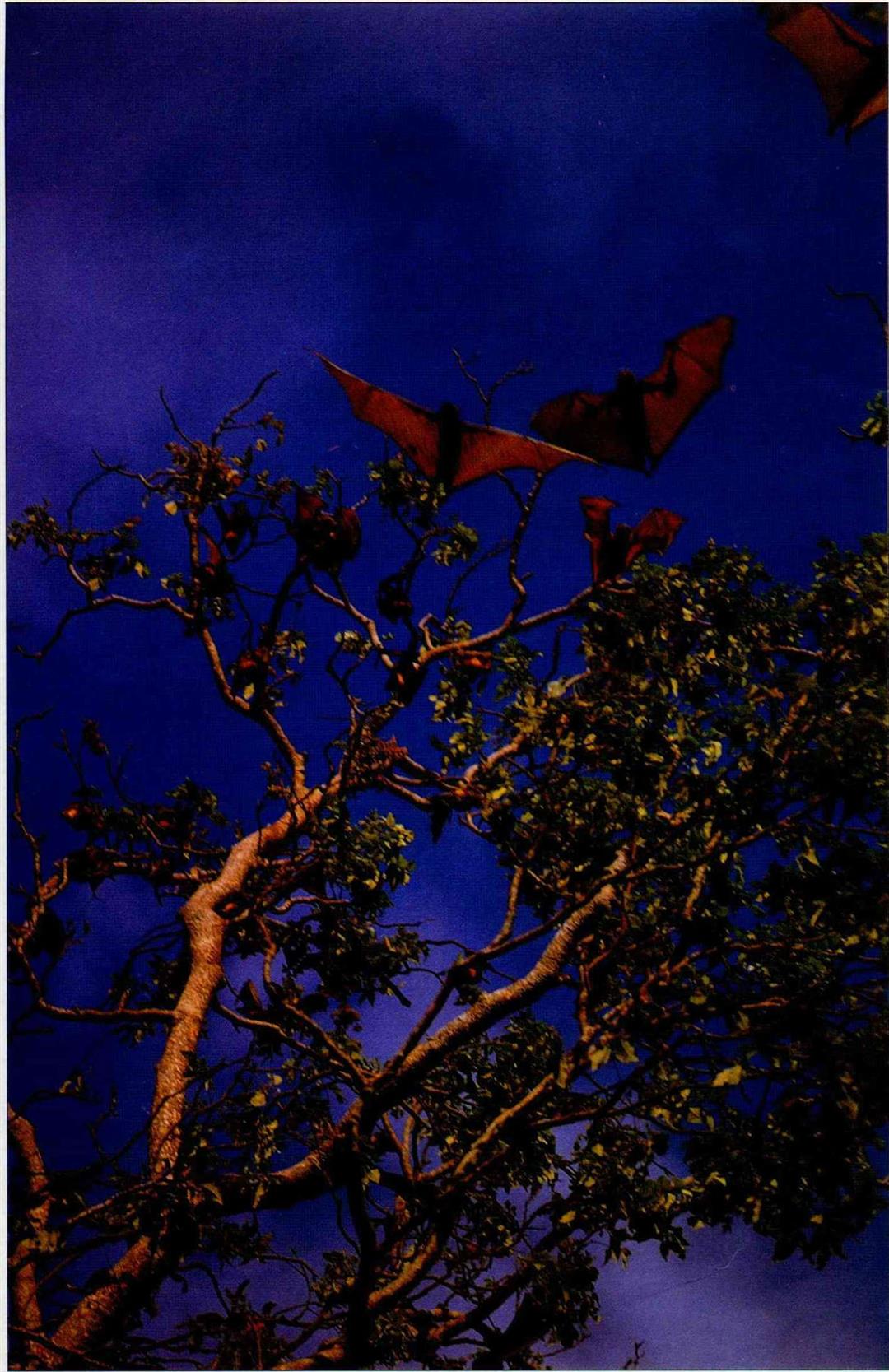
Fruit bats have a more robust physique than their insect-eating cousins.
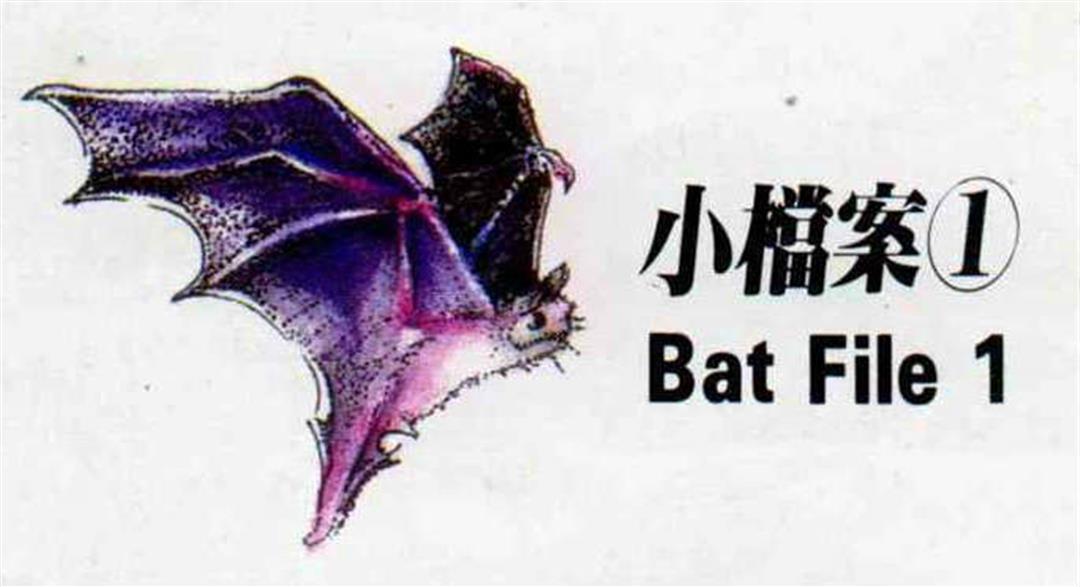
Bat File 1 It has been inferred from fossils that the bat in its present shape had already appeared 50 million years ago, during the dawn of the mammals and millions of years before the earliest ancestor of mankind that has been discovered. Zoologists think that bats evolved from a gliding, thin-skinned insect-eating mammal. Insect-eating mammals had already begun to appear when dinosaurs ruled the earth, 2.5 billion years ago. They gradually took the place of the declining dinosaurs and established the kingdom of the mammals. Bats, as insect-eating mammals that had passed the gliding stage, gained their present-day technique of flying.
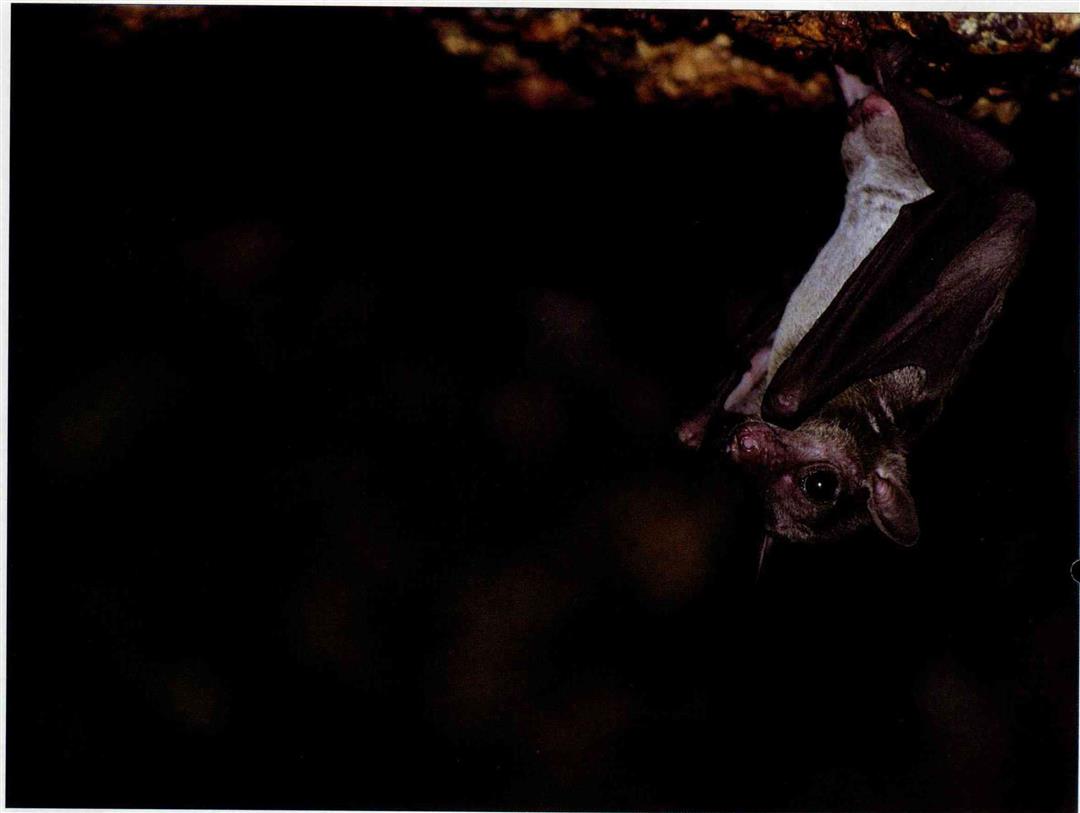
Fruit-eating Flying Foxes derive their name from their striking resemblance to foxes.
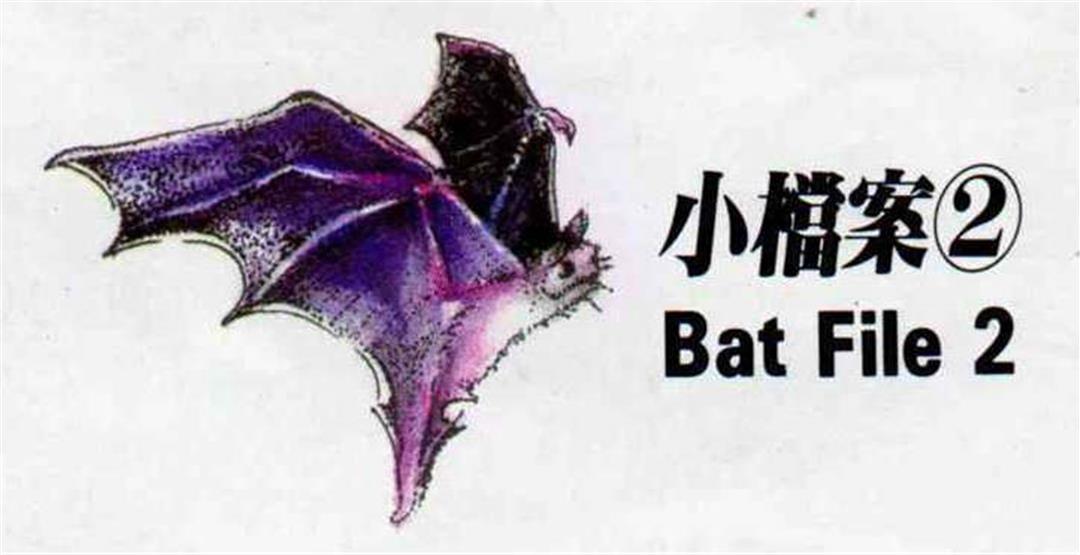
Bat File 2 An ultrasonic system of echolocation allows the bat to come and go at night. It has not completely lost the power of vision, although it cannot see colors, seeing things in black and white during the day. Perhaps this is because colors are not important at night, although the bat's eyes are certainly not useless. If a bat cannot find its way though, it can always get home by sonar.
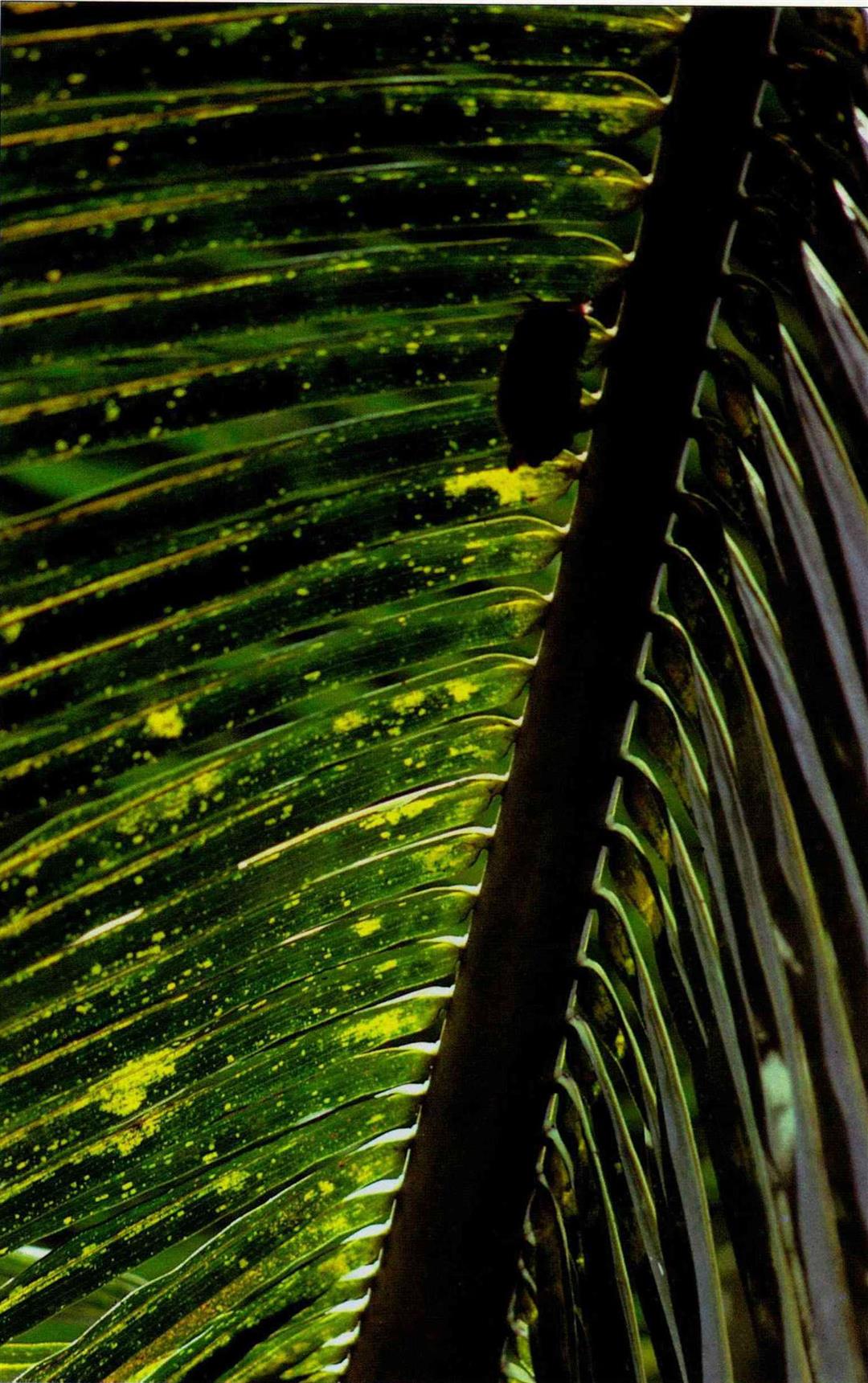
An insect-eating bat roosting in a tree.
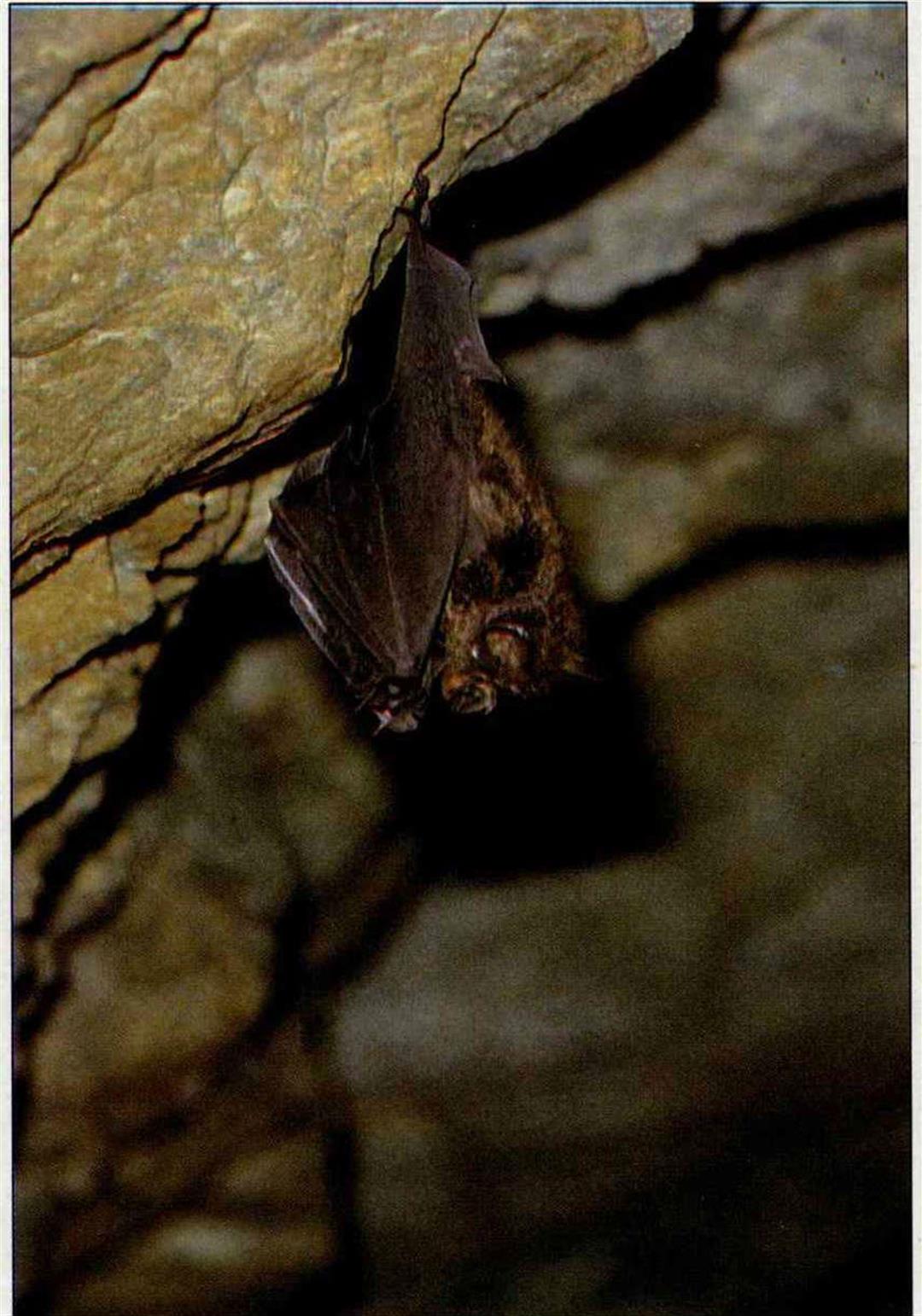
Before it studies climbing the young bat can only hang from its mother's breast wherever she might go. (photo by Lu Dao-jye)
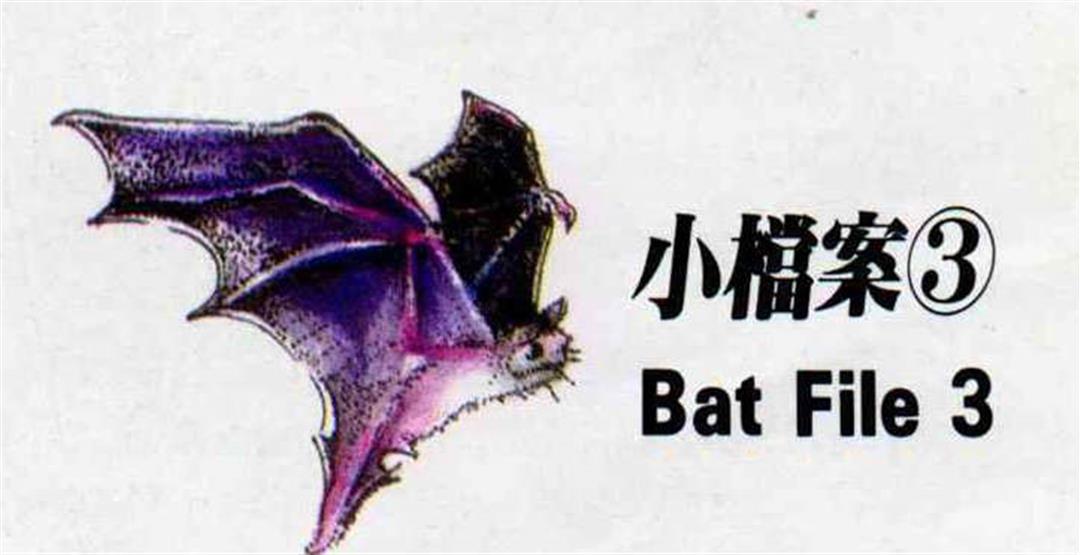
Bat File 3 People have tried without success to understand how the bat's sonar system works. Yet some of the bat's prey have managed to come up with their own systems of defense: In the Americas there is a kind of moth that can hear the bat's sonar and immediately lands on the ground when it hears the enemy approach; there are also insects that emit a high frequency signal which throws the bat's sonar into confusion and gives them a chance to escape.

There are more than 30 kinds of bat in the world that live in human habitations, which are suitable as secure and peaceful homes. (photo by Lu Dao-jye)
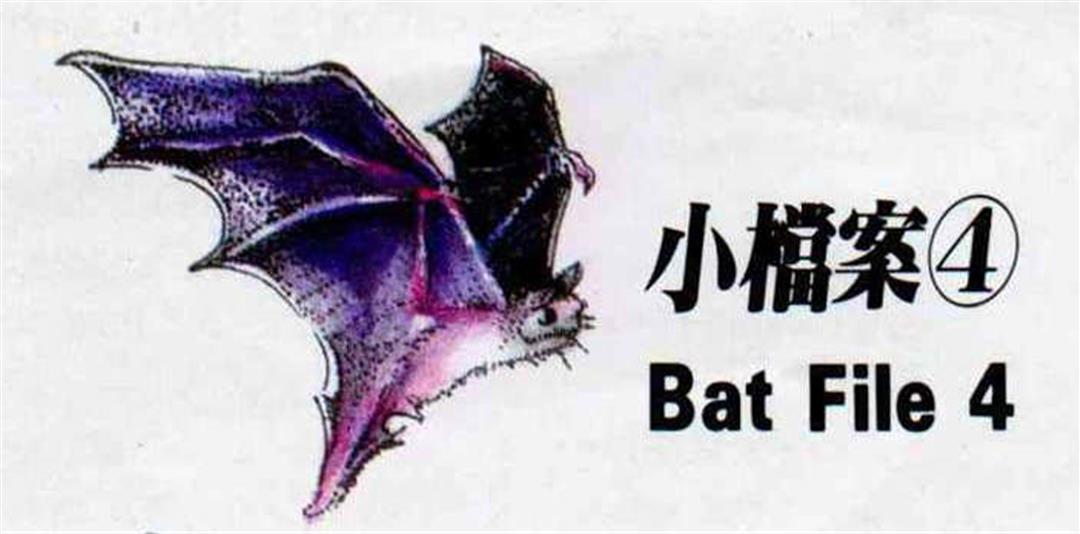
Bat File 4 Bats can live for 24 years, which is about the same as large animals such as the mountain goat, leopard and bison. Mammals of a similar constitution to the bat, such as the mouse, only live for five or six years.
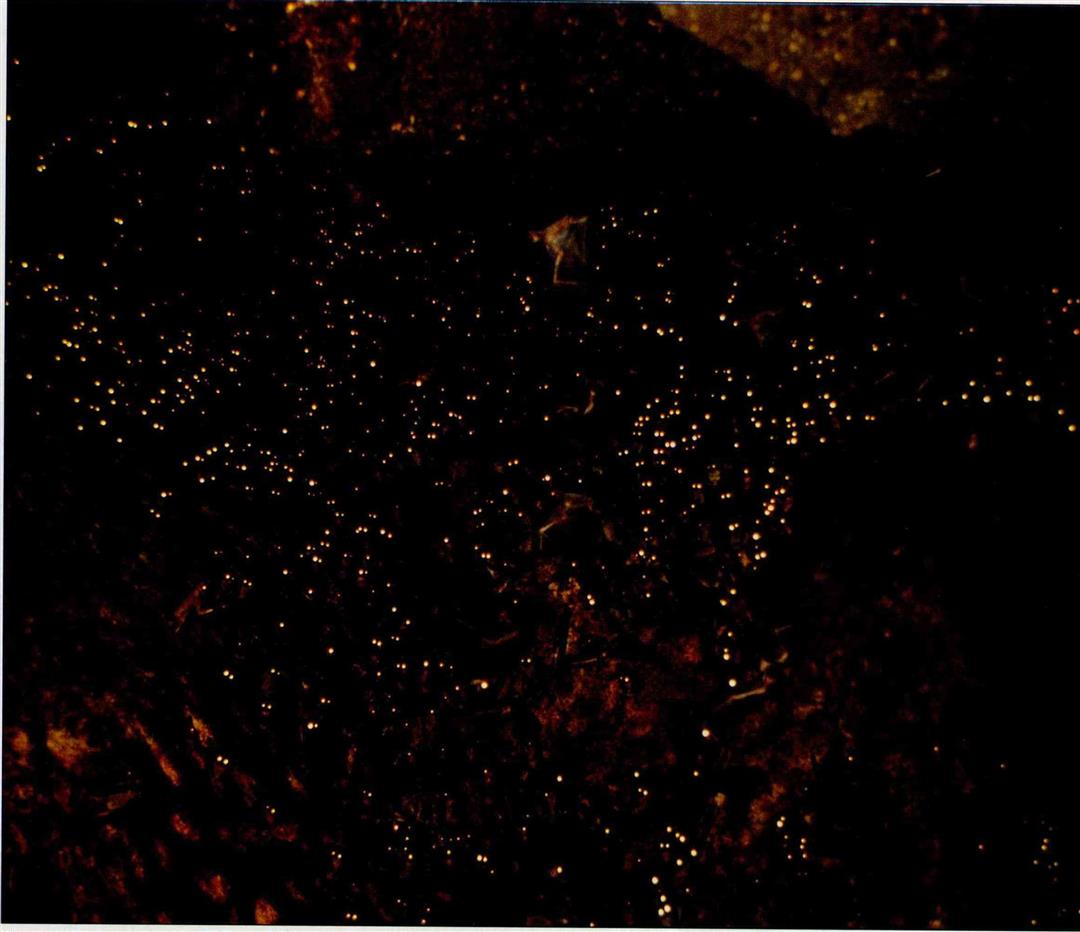
A starlit sky? No, it's a lightless bat cave!

Bat File 5 Bat Roosts and Distribution of Bats in Taiwan Bats mostly roost under the eaves of houses, in caves and in holes in trees. If you want to preserve the bat, first do a "population survey." These are the places where Lu Dao-jye has observed bats.(map by Lu Dao-jye) (art by lee Su-ling)